人教版高中英语必修4 unit1Women of achievement grammar---主谓一致教学课件 (共46张)
文档属性
| 名称 | 人教版高中英语必修4 unit1Women of achievement grammar---主谓一致教学课件 (共46张) | 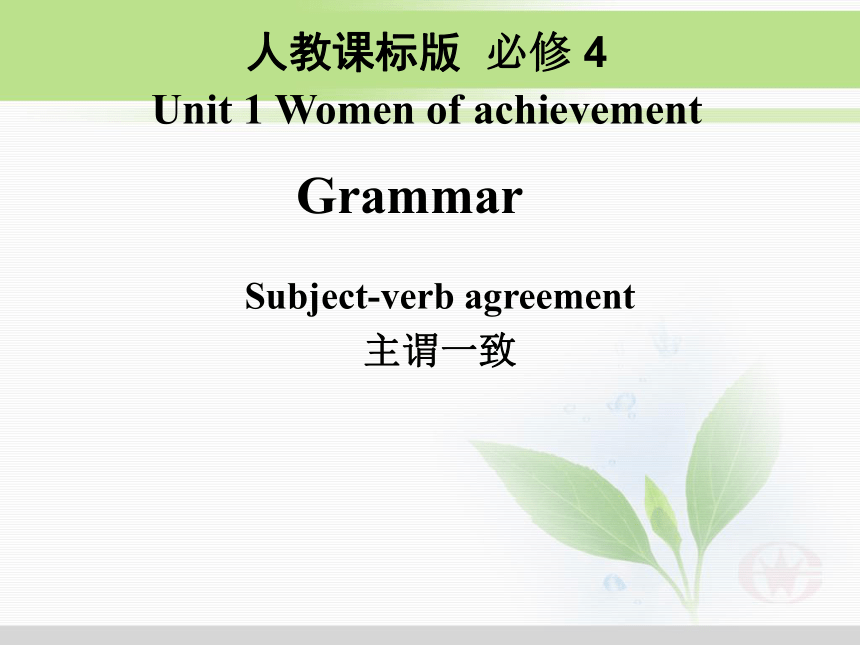 | |
| 格式 | zip | ||
| 文件大小 | 1.3MB | ||
| 资源类型 | 教案 | ||
| 版本资源 | 人教版(新课程标准) | ||
| 科目 | 英语 | ||
| 更新时间 | 2019-04-10 10:25:22 | ||
图片预览

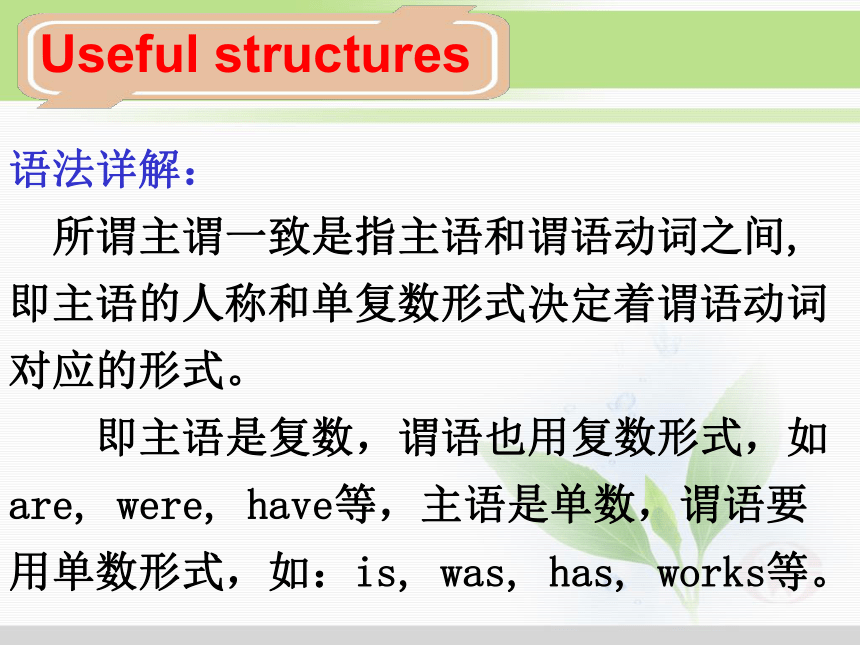


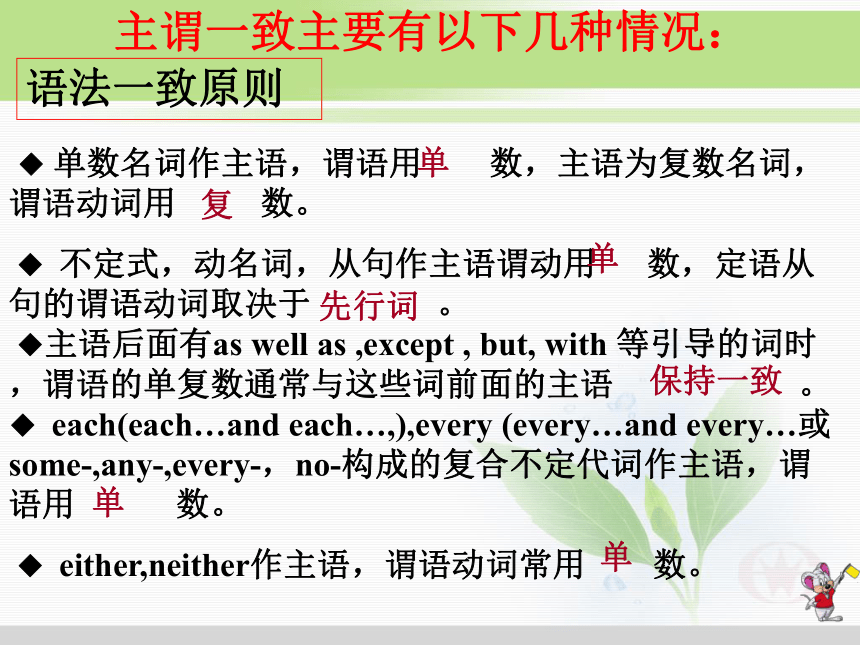




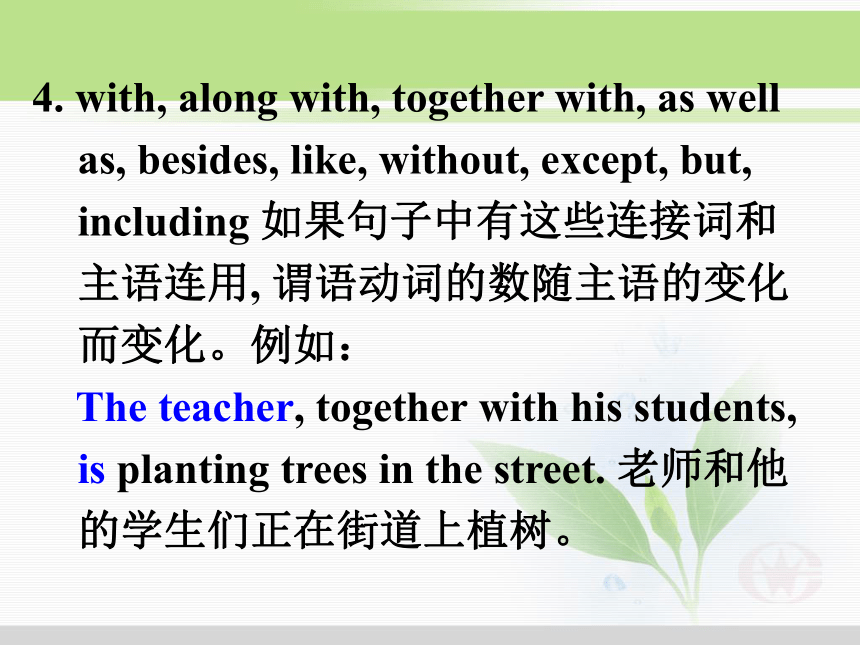
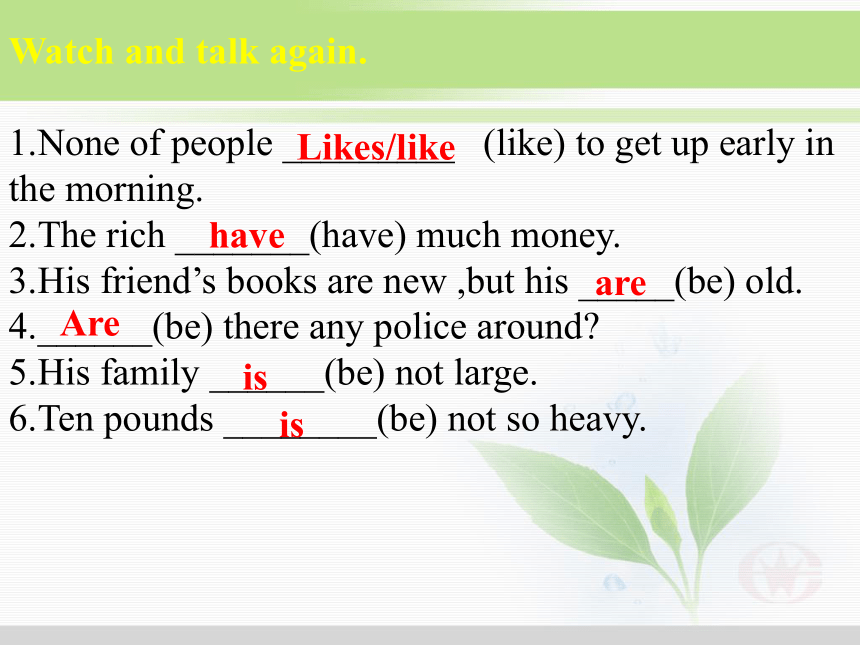
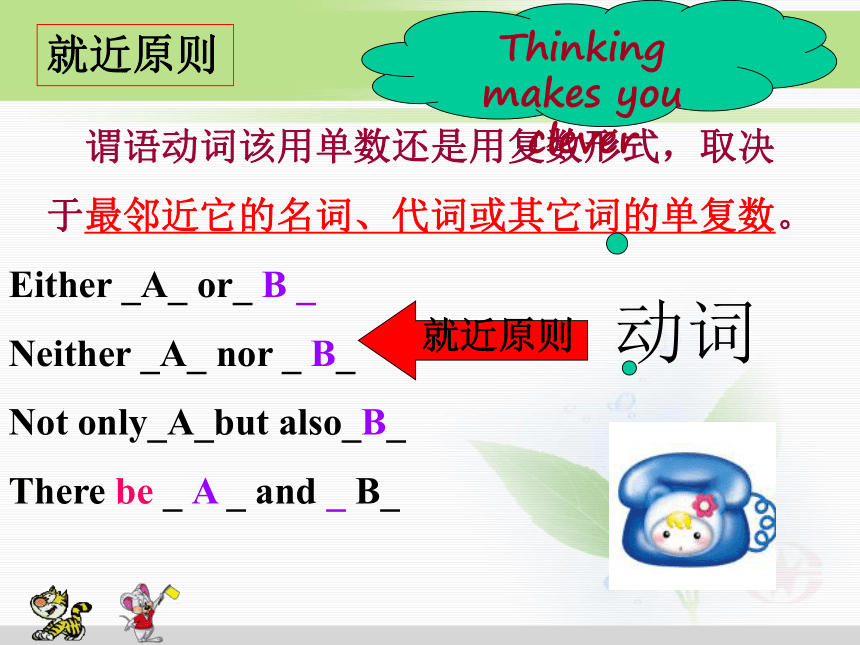
文档简介
课件46张PPT。人教课标版 必修 4
Unit 1 Women of achievement
GrammarSubject-verb agreement
主谓一致Useful structures语法详解:
所谓主谓一致是指主语和谓语动词之间,即主语的人称和单复数形式决定着谓语动词对应的形式。
即主语是复数,谓语也用复数形式,如are, were, have等,主语是单数,谓语要用单数形式,如:is, was, has, works等。The boy ___ diving.They ____ diving.Both Jack and Tim ___ diving.All of them ____ diving.Neither Jack nor Tim ___ walking.isareareisareFinish the following exercises:Watch、write and talk about them in pairs.
1.Something ______(be ) wrong with your watch.
2.He as well as I ______(be ) a football fan.
3.Nobody but Tom and Kate ______(be ) there
yesterday.
4.Every student _______(come) to school
on time in the morning.
5.The teacher with his students _____(be) having a
meeting now.
6.They are the fans who ____ (be) going to Beijing.
isiswascomes is are
◆ 单数名词作主语,谓语用 数,主语为复数名词,谓语动词用 数。
◆ 不定式,动名词,从句作主语谓动用 数,定语从句的谓语动词取决于 。
◆主语后面有as well as ,except , but, with 等引导的词时
,谓语的单复数通常与这些词前面的主语 。 ◆ each(each…and each…,),every (every…and every…或 some-,any-,every-,no-构成的复合不定代词作主语,谓语用 数。
◆ either,neither作主语,谓语动词常用 数。 复先行词保持一致单单单单语法一致原则主谓一致主要有以下几种情况:1. 由and连接的并列成分指的是同一概念,一个人的双重身份或匹配出现的事物时谓语动词为单数,由and连接的两个并列成分表示两个不同的概念时,谓语动词用复数。
The worker and writer is from Beijing. (那个工人兼作家…)
The worker and the writer are from Beijing. (那位工人和那位作家)Bread and butter is a daily food in the West.Both Cathy and her daughter Linda have gone fishing in Canada. 常见的由and连接的指一个概念的有:
the needle and thread 针线 salt and water盐和水 the folk and knife 刀叉 iron and steel 钢铁
time and tide 岁月2. 如果主语是不定式, 动词ing形式或主语从句的时候, 谓语动词用单数。
What he is doing seems very important. 他正在做的事情看起来很重要。
Collecting stamps is his hobby. 收集邮票是他的爱好。3. 定语从句的关系代词who, which, that在从句中作主语时,要与先行词的人称和数保持一致。
Those who enjoy singing may join us.
Tom, who is your friend, should help you.4. with, along with, together with, as well as, besides, like, without, except, but, including 如果句子中有这些连接词和主语连用, 谓语动词的数随主语的变化而变化。例如:
The teacher, together with his students, is planting trees in the street. 老师和他的学生们正在街道上植树。Watch and talk again.
1.None of people _________ (like) to get up early in the morning.
2.The rich _______(have) much money.
3.His friend’s books are new ,but his _____(be) old.
4.______(be) there any police around?
5.His family ______(be) not large.
6.Ten pounds ________(be) not so heavy.
Likes/likehaveareAreis is谓语动词该用单数还是用复数形式,取决
于最邻近它的名词、代词或其它词的单复数。
Either _A_ or_ B _
Neither _A_ nor _ B_
Not only_A_but also_B_
There be _ A _ and _ B_
动词Thinking makes you clever就近原则就近原则例如:
Not only he but also I am invited.
I or his brothers were to blame.
Neither I nor he is to attend the meeting.
Not only the students but also their teacher is enjoying the film.Not only I but Jane and Mary _____ tired of having one examination after another. (89’) A. is B. are C. am D. be析: 由“or, either…or, neither…nor, not…but, not only… but also”连接两个并列主语时,动词与靠近的主语保持一致。B1. A woman with some children ______ soon.
A. is coming B. are coming
C. has come D. have come
2. No one except my parents ____ anything about this。
A. know B. knows
C. is known D. are knownNo one knows anything about this except my parents.概念一致原则 所谓概念一致原则是指谓语动词和主语一致不是取决于主语的语法形式, 而是其实际意义。有的主语名词在形式上是单数, 但在意义上却是复数;有的主语名词在形式上是复数, 但在意义上却是单数。 ◆主语是family , police等词,谓语根据意义可用 数.
◆名词性物主代词作主语,谓语取决于它代指的 所 表示的意义。
◆时间、距离、金钱再多也是 数。
◆ None of +复数名词作主语,谓语可用 数形式。
◆ all, some, most, any, the rest, 分数或百分数等作主语时,谓语依照后面的 而确定。
◆ The +adj.作主语,谓语用 数。
单或复名词单或复名词的单复数复单1. 不定代词all, more, some, any, none作主语, 谓语动词视情况而定。All of the apples ____ rotten.
所有的苹果都烂了。
All of the apple ____ rotten.
整个苹果都烂了。
不定代词all, more, some, any, none作主语,谓语动词视情况而定。 are is2. 集合名词作主语, 动词可用单数, 也可以用复数。主要由句子的意思决定。强调整体谓语动词用单数;指全体人员时, 动词则用复数。这一类常见的集合名词有public, family, class, crowd, population, team, group。His family ____ going out.
他们全家要外出。
His family ____ all music lovers.
他们全家人都是音乐爱好者。
集合名词作主语, 动词可用单数, 也可以用复数。主要由句子的意思决定。强调整体谓语动词用单数;指全体人员时, 动词则用复数。这一类常见的集合名词有public, family, class, crowd, population, team, group。is are 3. 某些名词如people, police, cattle等, 形式上是单数, 但意义上是复数, 谓语动词应用复数。people指“民族”时是例外。
The police are searching for a thief.
The cattle are eating grass on the hill.4. 复合不定代词作主语, 谓语动词要用单数,如someone, somebody, something, anybody, anyone, anything, everybody, everyone, everything, nobody, no one, nothing。
Someone is asking for you.
有人找你。
Nothing is found in the room.
在屋子里什么也没找到。5. 某些名词如clothes, trousers, shoes, glasses等, 通常只用其复数形式, 但当它们被a pair of 修饰时, 谓语动词用单数。如:
The pair of shoes is worn out.
这双鞋破了。
The shoes are worn out.
鞋子破了。6. 某些名词以s结尾如maths, politics, physics, news, plastics等, 谓语动词应用单数。
Physics is a very interesting subject. 物理是一门很有趣的学科。 7. every... and every ...; each ... and each ...; no ... and no ... 在以上短 语中and连接的单数名词, 整个短语 在句中作主语时, 谓语动词常使用单数。
Each man and each woman is asked to attend. Every boy and every girl in the class is diligent. 班级中的每个男孩女孩都很用功。
No sound and no voice is heard. 听不到任何声音。Everybody sits and waits in the shade of the trees while the family begins to wake up and move off. (P2)
[考例] —Did you go to the show last night?
—Yeah. Every boy and girl in the area ______ invited. (陕西 2008)
A. were B. have been C. has been D. was[点拨] 选D。主语是every boy and girl或every boy and every girl,表示单数概念,故谓语动词用单数,且是询问昨晚的情况,有明确的过去时间,所以应选择was。8. 以a number of作主语时, 谓语动词用复数; 以the number of 作主语时, 谓语动词用单数。
A number of new books are on the desk.
The number of students in you class is 50.
做主谓一致题的三原则:
一、语法一致原则
二、就近原则
三、概念一致原则Finish them and say the reasons.
1. Physics ________(be) my favourite subject.
2.A number of people_____ (be) watching TV.
3.The pair of pants _________ (need) mending.
4.The writer and teacher ______(be) coming.
5.The writer and the teacher_______ (be) coming.
isareneedsis are 由此我们要注意:
1、一些学科名词是以 -ics 结尾,如:maths, politics, physics 以及news等,作主语时,其谓语要用单数。
2. glasses, clothes, shoes, 等词作主语时,谓语用复数,但如果这些名词前有a (the) pair of等量词修饰时,谓语动词用单数。
3、and 连接两个单词做主语时,要看表示的
意义来决定谓语动词用单数形式还是用复数。
4、 a number of"许多",作定语修饰复数名词,谓语用复数;the number of"…的数量",主语是number,谓语用单数。 注意:
a (large) quantity of 修饰可数或不可数名词, 其短语作主语时, 谓语动词用单数。
A large quantity of people is needed here.quantities of 修饰可数或不可数名词, 其短语作主语时, 谓语动词一般用复数。例如:
Quantities of food (nuts) were on the table.
短语in quantity, in large quantities 意为 “大量”; in small quantities 意为“少量”。 a great deal of, a large amount of, 修饰不可数名词, 其短语作主语时, 谓语动词通常用单数; large amounts of 修饰不可数名词, 其短语作主语时, 谓语动词通常用复数。例如:A large amount of (A great deal of) damage was done in a very short time.
Large amounts of money were spent on the bridge. 表示数量的one and a half +名词复数, 谓语动词用单数形式。例如:
One and a half bananas is left on the table.
但 one +名词单数+a half,谓语动词用单数。高考链接1. As a result of destroying the forests, a large _____ of desert _____ covered the land. (上海2001)
A. number; has B. quantity; has
C. number; have D. quantity; haveB精析:a large number of 后面要接复数名词,所以A不能作为答案。因为desert是单数,所以要填 has。这句话的意思是“毁坏森林的结果是,大片沙漠覆盖了陆地.”答案 B2. ____ of the land in that district ____ covered with trees and grass. (上海2000)
A. Two fifth, is B. Two fifth, are
C. Two fifths, is D. Two fifths, areC精析: 分数的分子用基数词, 分母用序数词表示.如果分子大于1, 分母序数词后加-s。分数和百分比作主语时,谓语动词的形式取决于分数和百分数后面的名词。句子中的主语 land是单数, 所以谓语动词要用is covered。答案C。3. ____ people in the world are sending information by e-mail every day.(上海2001)
A. Several million B. Many millions
C. Several millions D. Many millionA精析: 在million前如果有具体的数字或 several等词时,要用单数形式。 many一般不与 million等词连用. 表示“数百万”,英语为 millions of。这句话的意思是“每天,世界上有几十万人通过 e-mail传递信息。”答案 A。4. Professor James will give us a lecture on the Western culture, but when and where _____ yet. (浙江2007)
A. hasn’t been decided B. haven’t decided
C. isn’t being decided D. aren’t decided
[点拨] “when and where (to do sth. 或+从句)”作主语时,谓语通常用单数。由题意可知要用被动,又由yet可知要用完成时态。A5. The father as well as his three children ___ skating on the frozen river every Sunday afternoon in winter. (辽宁2006)
A. is going B. go
C. goes D. are going
[点拨] 句子主语要和as well as 前面的成分the father保持一致,故谓语动词要用单数,又由every Sunday afternoon in winter可知应该用一般现在时。CHomeworkFinish the exercises in USING STRUCTURES on Page 43.Thank you !
Unit 1 Women of achievement
GrammarSubject-verb agreement
主谓一致Useful structures语法详解:
所谓主谓一致是指主语和谓语动词之间,即主语的人称和单复数形式决定着谓语动词对应的形式。
即主语是复数,谓语也用复数形式,如are, were, have等,主语是单数,谓语要用单数形式,如:is, was, has, works等。The boy ___ diving.They ____ diving.Both Jack and Tim ___ diving.All of them ____ diving.Neither Jack nor Tim ___ walking.isareareisareFinish the following exercises:Watch、write and talk about them in pairs.
1.Something ______(be ) wrong with your watch.
2.He as well as I ______(be ) a football fan.
3.Nobody but Tom and Kate ______(be ) there
yesterday.
4.Every student _______(come) to school
on time in the morning.
5.The teacher with his students _____(be) having a
meeting now.
6.They are the fans who ____ (be) going to Beijing.
isiswascomes is are
◆ 单数名词作主语,谓语用 数,主语为复数名词,谓语动词用 数。
◆ 不定式,动名词,从句作主语谓动用 数,定语从句的谓语动词取决于 。
◆主语后面有as well as ,except , but, with 等引导的词时
,谓语的单复数通常与这些词前面的主语 。 ◆ each(each…and each…,),every (every…and every…或 some-,any-,every-,no-构成的复合不定代词作主语,谓语用 数。
◆ either,neither作主语,谓语动词常用 数。 复先行词保持一致单单单单语法一致原则主谓一致主要有以下几种情况:1. 由and连接的并列成分指的是同一概念,一个人的双重身份或匹配出现的事物时谓语动词为单数,由and连接的两个并列成分表示两个不同的概念时,谓语动词用复数。
The worker and writer is from Beijing. (那个工人兼作家…)
The worker and the writer are from Beijing. (那位工人和那位作家)Bread and butter is a daily food in the West.Both Cathy and her daughter Linda have gone fishing in Canada. 常见的由and连接的指一个概念的有:
the needle and thread 针线 salt and water盐和水 the folk and knife 刀叉 iron and steel 钢铁
time and tide 岁月2. 如果主语是不定式, 动词ing形式或主语从句的时候, 谓语动词用单数。
What he is doing seems very important. 他正在做的事情看起来很重要。
Collecting stamps is his hobby. 收集邮票是他的爱好。3. 定语从句的关系代词who, which, that在从句中作主语时,要与先行词的人称和数保持一致。
Those who enjoy singing may join us.
Tom, who is your friend, should help you.4. with, along with, together with, as well as, besides, like, without, except, but, including 如果句子中有这些连接词和主语连用, 谓语动词的数随主语的变化而变化。例如:
The teacher, together with his students, is planting trees in the street. 老师和他的学生们正在街道上植树。Watch and talk again.
1.None of people _________ (like) to get up early in the morning.
2.The rich _______(have) much money.
3.His friend’s books are new ,but his _____(be) old.
4.______(be) there any police around?
5.His family ______(be) not large.
6.Ten pounds ________(be) not so heavy.
Likes/likehaveareAreis is谓语动词该用单数还是用复数形式,取决
于最邻近它的名词、代词或其它词的单复数。
Either _A_ or_ B _
Neither _A_ nor _ B_
Not only_A_but also_B_
There be _ A _ and _ B_
动词Thinking makes you clever就近原则就近原则例如:
Not only he but also I am invited.
I or his brothers were to blame.
Neither I nor he is to attend the meeting.
Not only the students but also their teacher is enjoying the film.Not only I but Jane and Mary _____ tired of having one examination after another. (89’) A. is B. are C. am D. be析: 由“or, either…or, neither…nor, not…but, not only… but also”连接两个并列主语时,动词与靠近的主语保持一致。B1. A woman with some children ______ soon.
A. is coming B. are coming
C. has come D. have come
2. No one except my parents ____ anything about this。
A. know B. knows
C. is known D. are knownNo one knows anything about this except my parents.概念一致原则 所谓概念一致原则是指谓语动词和主语一致不是取决于主语的语法形式, 而是其实际意义。有的主语名词在形式上是单数, 但在意义上却是复数;有的主语名词在形式上是复数, 但在意义上却是单数。 ◆主语是family , police等词,谓语根据意义可用 数.
◆名词性物主代词作主语,谓语取决于它代指的 所 表示的意义。
◆时间、距离、金钱再多也是 数。
◆ None of +复数名词作主语,谓语可用 数形式。
◆ all, some, most, any, the rest, 分数或百分数等作主语时,谓语依照后面的 而确定。
◆ The +adj.作主语,谓语用 数。
单或复名词单或复名词的单复数复单1. 不定代词all, more, some, any, none作主语, 谓语动词视情况而定。All of the apples ____ rotten.
所有的苹果都烂了。
All of the apple ____ rotten.
整个苹果都烂了。
不定代词all, more, some, any, none作主语,谓语动词视情况而定。 are is2. 集合名词作主语, 动词可用单数, 也可以用复数。主要由句子的意思决定。强调整体谓语动词用单数;指全体人员时, 动词则用复数。这一类常见的集合名词有public, family, class, crowd, population, team, group。His family ____ going out.
他们全家要外出。
His family ____ all music lovers.
他们全家人都是音乐爱好者。
集合名词作主语, 动词可用单数, 也可以用复数。主要由句子的意思决定。强调整体谓语动词用单数;指全体人员时, 动词则用复数。这一类常见的集合名词有public, family, class, crowd, population, team, group。is are 3. 某些名词如people, police, cattle等, 形式上是单数, 但意义上是复数, 谓语动词应用复数。people指“民族”时是例外。
The police are searching for a thief.
The cattle are eating grass on the hill.4. 复合不定代词作主语, 谓语动词要用单数,如someone, somebody, something, anybody, anyone, anything, everybody, everyone, everything, nobody, no one, nothing。
Someone is asking for you.
有人找你。
Nothing is found in the room.
在屋子里什么也没找到。5. 某些名词如clothes, trousers, shoes, glasses等, 通常只用其复数形式, 但当它们被a pair of 修饰时, 谓语动词用单数。如:
The pair of shoes is worn out.
这双鞋破了。
The shoes are worn out.
鞋子破了。6. 某些名词以s结尾如maths, politics, physics, news, plastics等, 谓语动词应用单数。
Physics is a very interesting subject. 物理是一门很有趣的学科。 7. every... and every ...; each ... and each ...; no ... and no ... 在以上短 语中and连接的单数名词, 整个短语 在句中作主语时, 谓语动词常使用单数。
Each man and each woman is asked to attend. Every boy and every girl in the class is diligent. 班级中的每个男孩女孩都很用功。
No sound and no voice is heard. 听不到任何声音。Everybody sits and waits in the shade of the trees while the family begins to wake up and move off. (P2)
[考例] —Did you go to the show last night?
—Yeah. Every boy and girl in the area ______ invited. (陕西 2008)
A. were B. have been C. has been D. was[点拨] 选D。主语是every boy and girl或every boy and every girl,表示单数概念,故谓语动词用单数,且是询问昨晚的情况,有明确的过去时间,所以应选择was。8. 以a number of作主语时, 谓语动词用复数; 以the number of 作主语时, 谓语动词用单数。
A number of new books are on the desk.
The number of students in you class is 50.
做主谓一致题的三原则:
一、语法一致原则
二、就近原则
三、概念一致原则Finish them and say the reasons.
1. Physics ________(be) my favourite subject.
2.A number of people_____ (be) watching TV.
3.The pair of pants _________ (need) mending.
4.The writer and teacher ______(be) coming.
5.The writer and the teacher_______ (be) coming.
isareneedsis are 由此我们要注意:
1、一些学科名词是以 -ics 结尾,如:maths, politics, physics 以及news等,作主语时,其谓语要用单数。
2. glasses, clothes, shoes, 等词作主语时,谓语用复数,但如果这些名词前有a (the) pair of等量词修饰时,谓语动词用单数。
3、and 连接两个单词做主语时,要看表示的
意义来决定谓语动词用单数形式还是用复数。
4、 a number of"许多",作定语修饰复数名词,谓语用复数;the number of"…的数量",主语是number,谓语用单数。 注意:
a (large) quantity of 修饰可数或不可数名词, 其短语作主语时, 谓语动词用单数。
A large quantity of people is needed here.quantities of 修饰可数或不可数名词, 其短语作主语时, 谓语动词一般用复数。例如:
Quantities of food (nuts) were on the table.
短语in quantity, in large quantities 意为 “大量”; in small quantities 意为“少量”。 a great deal of, a large amount of, 修饰不可数名词, 其短语作主语时, 谓语动词通常用单数; large amounts of 修饰不可数名词, 其短语作主语时, 谓语动词通常用复数。例如:A large amount of (A great deal of) damage was done in a very short time.
Large amounts of money were spent on the bridge. 表示数量的one and a half +名词复数, 谓语动词用单数形式。例如:
One and a half bananas is left on the table.
但 one +名词单数+a half,谓语动词用单数。高考链接1. As a result of destroying the forests, a large _____ of desert _____ covered the land. (上海2001)
A. number; has B. quantity; has
C. number; have D. quantity; haveB精析:a large number of 后面要接复数名词,所以A不能作为答案。因为desert是单数,所以要填 has。这句话的意思是“毁坏森林的结果是,大片沙漠覆盖了陆地.”答案 B2. ____ of the land in that district ____ covered with trees and grass. (上海2000)
A. Two fifth, is B. Two fifth, are
C. Two fifths, is D. Two fifths, areC精析: 分数的分子用基数词, 分母用序数词表示.如果分子大于1, 分母序数词后加-s。分数和百分比作主语时,谓语动词的形式取决于分数和百分数后面的名词。句子中的主语 land是单数, 所以谓语动词要用is covered。答案C。3. ____ people in the world are sending information by e-mail every day.(上海2001)
A. Several million B. Many millions
C. Several millions D. Many millionA精析: 在million前如果有具体的数字或 several等词时,要用单数形式。 many一般不与 million等词连用. 表示“数百万”,英语为 millions of。这句话的意思是“每天,世界上有几十万人通过 e-mail传递信息。”答案 A。4. Professor James will give us a lecture on the Western culture, but when and where _____ yet. (浙江2007)
A. hasn’t been decided B. haven’t decided
C. isn’t being decided D. aren’t decided
[点拨] “when and where (to do sth. 或+从句)”作主语时,谓语通常用单数。由题意可知要用被动,又由yet可知要用完成时态。A5. The father as well as his three children ___ skating on the frozen river every Sunday afternoon in winter. (辽宁2006)
A. is going B. go
C. goes D. are going
[点拨] 句子主语要和as well as 前面的成分the father保持一致,故谓语动词要用单数,又由every Sunday afternoon in winter可知应该用一般现在时。CHomeworkFinish the exercises in USING STRUCTURES on Page 43.Thank you !
同课章节目录
